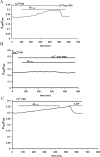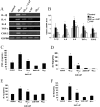Broad-spectrum effects of 4-aminopyridine to modulate amyloid beta1-42-induced cell signaling and functional responses in human microglia
- PMID: 17093087
- PMCID: PMC6674791
- DOI: 10.1523/JNEUROSCI.2490-06.2006
Broad-spectrum effects of 4-aminopyridine to modulate amyloid beta1-42-induced cell signaling and functional responses in human microglia
Abstract
We investigated the modulating actions of the nonselective K(+) channel blocker 4-aminopyridine (4-AP) on amyloid beta (Abeta(1-42))-induced human microglial signaling pathways and functional processes. Whole-cell patch-clamp studies showed acute application of Abeta(1-42) (5 mum) to human microglia led to rapid expression of a 4-AP-sensitive, non-inactivating outwardly rectifying K(+) current (I(K)). Intracellular application of the nonhydrolyzable analog of GTP, GTPgammaS, induced an outward K(+) current with similar properties to the Abeta(1-42)-induced I(K) including sensitivity to 4-AP (IC(50) = 5 mm). Reverse transcriptase-PCR showed a rapid expression of a delayed rectifier Kv3.1 channel in Abeta(1-42)-treated microglia. Abeta(1-42) peptide also caused a slow, progressive increase in levels of [Ca(2+)](i) (intracellular calcium) that was partially blocked by 4-AP. Chronic exposure of human microglia to Abeta(1-42) led to enhanced p38 mitogen-activated protein kinase and nuclear factor kappaB expression with factors inhibited by 4-AP. Abeta(1-42) also induced the expression and production of the pro-inflammatory cytokines interleukin (IL)-1beta, IL-6, and tumor necrosis factor-alpha, the chemokine IL-8, and the enzyme cyclooxygenase-2; 4-AP was effective in reducing all of these pro-inflammatory mediators. Additionally, toxicity of supernatant from Abeta(1-42)-treated microglia on cultured rat hippocampal neurons was reduced if 4-AP was included with peptide. In vivo, injection of Abeta(1-42) into rat hippocampus induced neuronal damage and increased microglial activation. Daily administration of 1 mg/kg 4-AP was found to suppress microglial activation and exhibited neuroprotection. The overall results suggest that 4-AP modulation of an Abeta(1-42)-induced I(K) (candidate channel Kv3.1) and intracellular signaling pathways in human microglia could serve as a therapeutic strategy for neuroprotection in Alzheimer's disease pathology.
Figures









Similar articles
-
Nuclear factor-kappaB activation by reactive oxygen species mediates voltage-gated K+ current enhancement by neurotoxic beta-amyloid peptides in nerve growth factor-differentiated PC-12 cells and hippocampal neurones.J Neurochem. 2005 Aug;94(3):572-86. doi: 10.1111/j.1471-4159.2005.03075.x. Epub 2005 Jun 22. J Neurochem. 2005. PMID: 15969743
-
PACAP inhibits delayed rectifier potassium current via a cAMP/PKA transduction pathway: evidence for the involvement of I k in the anti-apoptotic action of PACAP.Eur J Neurosci. 2004 Mar;19(6):1446-58. doi: 10.1111/j.1460-9568.2004.03227.x. Eur J Neurosci. 2004. PMID: 15066141
-
The mixed-lineage kinase 3 inhibitor URMC-099 facilitates microglial amyloid-β degradation.J Neuroinflammation. 2016 Jul 11;13(1):184. doi: 10.1186/s12974-016-0646-z. J Neuroinflammation. 2016. PMID: 27401058 Free PMC article.
-
Up-regulation and increased activity of KV3.4 channels and their accessory subunit MinK-related peptide 2 induced by amyloid peptide are involved in apoptotic neuronal death.Mol Pharmacol. 2007 Sep;72(3):665-73. doi: 10.1124/mol.107.034868. Epub 2007 May 10. Mol Pharmacol. 2007. PMID: 17495071
-
Cellular mechanisms for amyloid beta-protein activation of rat cholinergic basal forebrain neurons.J Neurophysiol. 2001 Sep;86(3):1312-20. doi: 10.1152/jn.2001.86.3.1312. J Neurophysiol. 2001. PMID: 11535679
Cited by
-
Status epilepticus induces a particular microglial activation state characterized by enhanced purinergic signaling.J Neurosci. 2008 Sep 10;28(37):9133-44. doi: 10.1523/JNEUROSCI.1820-08.2008. J Neurosci. 2008. PMID: 18784294 Free PMC article.
-
Microglial VEGF receptor response is an integral chemotactic component in Alzheimer's disease pathology.J Neurosci. 2009 Jan 7;29(1):3-13. doi: 10.1523/JNEUROSCI.2888-08.2009. J Neurosci. 2009. PMID: 19129379 Free PMC article.
-
Neuroinflammation in Alzheimer's disease: chemokines produced by astrocytes and chemokine receptors.Int J Clin Exp Pathol. 2014 Dec 1;7(12):8342-55. eCollection 2014. Int J Clin Exp Pathol. 2014. PMID: 25674199 Free PMC article. Review.
-
Predominant functional expression of Kv1.3 by activated microglia of the hippocampus after Status epilepticus.PLoS One. 2009 Aug 26;4(8):e6770. doi: 10.1371/journal.pone.0006770. PLoS One. 2009. PMID: 19707551 Free PMC article.
-
CD40-CD40 ligand interactions in human microglia induce CXCL8 (interleukin-8) secretion by a mechanism dependent on activation of ERK1/2 and nuclear translocation of nuclear factor-kappaB (NFkappaB) and activator protein-1 (AP-1).J Neurosci Res. 2008 Feb 15;86(3):630-9. doi: 10.1002/jnr.21525. J Neurosci Res. 2008. PMID: 17918746 Free PMC article.
References
-
- Akiyama H, Barger S, Barnum S, Bradt B, Bauer J, Cole GM, Cooper NR, Eikelenboom P, Emmerling M, Fiebich BL, Finch CE, Frautschy S, Griffin WS, Hampel H, Hull M, Landreth G, Lue L, Mrak R, MacKenzie IR, McGeer PL, et al. Inflammation and Alzheimer's disease. Neurobiol Aging. 2000;21:383–421. - PMC - PubMed
-
- Arends YM, Duyckaerts C, Rozemuller JM, Eikelenboom P, Hauw JJ. Microglia, amyloid and dementia in Alzheimer disease. A correlative study. Neurobiol Aging. 2000;21:39–47. - PubMed
-
- Boland K, Behrens M, Choi D, Manias K, Perlmutter DH. The serpin-enzyme complex receptor recognizes soluble, nontoxic amyloid-beta peptide but not aggregated, cytotoxic amyloid-beta peptide. J Biol Chem. 1996;271:18032–18044. - PubMed
Publication types
MeSH terms
Substances
LinkOut - more resources
Full Text Sources
Research Materials
Miscellaneous
